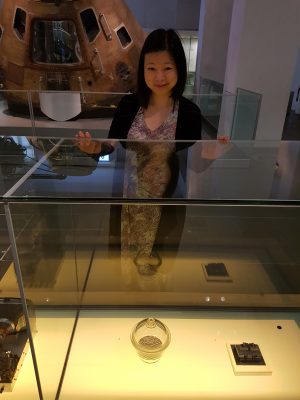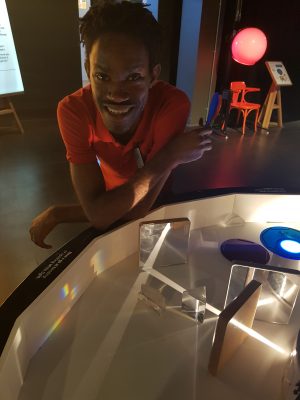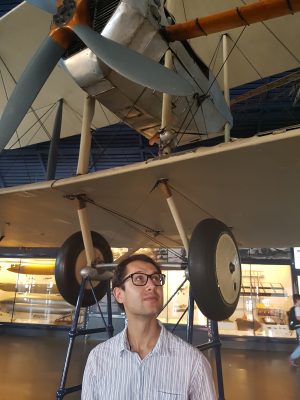On this Day in 1909 the Science Museum officially became an independent institution. In celebration of our birthday we’ve asked staff to share their favourite objects from across the museum. Our staff make the museum an exciting, vibrant place to visit and each has their own artefact that inspires them, with its own unique story.
Incubator Used in Creation of the World’s First ‘Test-Tube Babies’, 1977 from Making the Modern World:
Ling, Contemporary Science Manager Exhibitions

“Picture this – the first embryos conceived outside of the human body once called this incubator home. One of those embryos grew up to become Louise Joy Brown, the world’s first IVF (in vitro fertilisation) baby. I like how this simple glass jar reminds me that so many ideas and technologies we take for granted today were once thought of as wildly radical. Today, I see IVF clinic posters all over the tube. But it wasn’t too long ago that Louise’s parents were receiving hate mail from strangers who felt entitled to make their opinions known regarding their daughter’s remarkable birth.”
Louise Brown, the world’s first test ‘test-tube baby’ was born on 28 July 1978. Louise’s parents had spent ten years trying to conceive before they were treated using the in vitro fertilisation (IVF) technique developed by British researchers Robert Edwards and Patrick Steptoe. Robert Edwards first achieved fertilisation with human eggs in 1968, although it took a further decade before Louise was born. During this time, Patrick Steptoe perfected a method for obtaining human eggs from the ovaries by keyhole surgery, using a laparoscope. With Edwards and Steptoe working together, eggs were removed from the mother, fertilised in a culture dish (a process known as in vitro) and then reintroduced into the womb a few days later. While in vitro this glass incubator was used to keep the embryos at body temperature as they developed inside. Since Louise’s birth over 5 million babies have been born thanks to IVF techniques. Robert Edwards was awarded the Nobel Prize in Physiology or Medicine in 2010 for his work on IVF.
Birthday Fun Fact: Stephenson’s Rocket, one of the most famous steam locomotives in the world on display in Making the Modern World was stored at Brocket Hall in Hertfordshire during World War II. Brocket Hall is often used for filming, most notably the BBC TV version of “Pride and Prejudice” starring Colin Firth.
The Light Table from Wonderlab: The Equinor Gallery:
Dwayne, Explainer

“I studied Anthropology at university with a focus on learning and development; as such I love seeing how people absorb and decode knowledge and there is no better place to see this in practice than at the Science Museum. The Light Table is my favourite object to interact with visitors over because light is something that is literally all around us, and vital for so many things. Through setting up different displays of light I like prompting our visitors to think about how light affects them and its place not just in scientific experiments but in our everyday lives.”
Wonderlab: The Equinor Gallery is the UK’s biggest interactive science gallery. The permanent gallery features unique exhibits, specially-commissioned artworks, explosive demonstrations and immersive experiences led by the Museum’s talented team of science communicators, Explainers, to inspire visitors of all ages to wonder at the science and mathematics that shape our lives. With over 50 exhibits across seven zones (including the Light zone) visitors to the gallery will explore the incredible phenomena that occur around us every day, with topics as diverse as sound, forces, light, electricity, maths, matter and space. Wonderlab is also home to three live demonstration areas and a 120-capacity showspace inspired by the Royal Institution’s world-renowned Faraday Theatre.
Birthday Fun Fact: The first ‘Children’s Gallery’ in the museum opened in December 1931. It aimed to stimulate the curiosity of children, and included a large number of working models. ‘I was one of the first visitors to the original Children’s Gallery, which opened back in 1931, and can still remember the wonderful door that opened before I had even reached it.’ – Sir David Attenborough.
Vickers Vimy Aircraft, 1919, from Flight:
Ben, PhD Researcher in Conservation

“The Vickers Vimy aircraft is my favourite object as it represents such a great human achievement. It made the first non-stop flight over the Atlantic Ocean in 1919, a journey that is now routine but was then incredibly dangerous. For my PhD research I am studying how to conserve this plane and others like it. As it gets older the fabric covering over the wings tears, and I’ve been investigating how this can best be prevented and repaired to keep the planes safe for future generations.”
The Vickers Vimy aircraft was used by John Alcock and Arthur Whitten Brown to make the first non-stop flight across the Atlantic. In 1913 Lord Northcliffe, proprietor of the Daily Mail, offered a prize of £10,000 to the first aviator to cross the North Atlantic. The outbreak of the First World War intervened but attempts resumed in 1919. The Vimy had been designed in 1917 as a heavy bomber. Its great asset for the Atlantic attempt was its two Rolls-Royce Eagle engines – probably the most reliable aero engines then made. In June 1919 it left St.John’s, Newfoundland before landing in Clifden, Co.Galway after a perilous flight across the Atlantic. For this arduous journey the Vimy had been specially constructed to perform the flight, as additional fuel tanks were added to it in order to extend the range it could travel. Later Alcock and Whitten Brown were awarded KBE’s in recognition of their skill and bravery.
Birthday Fun Fact: The Wright flyer, the world’s first heavier than air aircraft to fly, was originally displayed at the Science Museum. Orville Wright refused to donate the aircraft to the Smithsonian museum, instead loaning it to the Science Museum in 1928. The Science Museum had a replica of the aircraft built (on display in the Flight gallery) before returning the original to the Smithsonian in 1948.
Dr Macaura’s Blood Circulator, 1890-1910 from temporary exhibition Wounded: Conflict, Casualties and Care:
Olga, Volunteer

“I studied Health & Human Sciences at university and have always found the history behind attitudes towards mental health fascinating. This led to me working on Wounded: Conflict, Casualties and Care. I got to research the history of medicine and discovered the instruments used to treat ‘shell-shocked’ soldiers like the blood circulator by Dr Macaura. While it was originally invented as a tool to help hysterical women relax it was later used on soldiers to ease their pain. Doctors at the time thought the best option for healing soldiers was through physical treatment as psychological damage wasn’t understood in the way it is now. Instruments like this object marked a real change in how scientists and doctors helped people suffering from trauma.”
Two thousand vibrations per minute are produced by cranking the handle of this massager, which was applied to the body. Advertised as a blood circulator, the massager was claimed to cure pain, deafness, anaemia, heart disease, cramp, polio and ‘women’s problems’. It was invented by Gerald Joseph Macaura and thousands of the devices were made with this example being produced by British Appliances Manufacturing Co, based in Leeds, England. During the war makers of this vibrating massager advertised directly to discharged soldiers. They claimed their device could relieve pain, and stimulate paralysed muscles and vocal chords.
Birthday Fun Fact: The Science Museum has held temporary exhibitions on typewriters, rubbish, 3D Printing, noise abatement, razors and Dr Who.